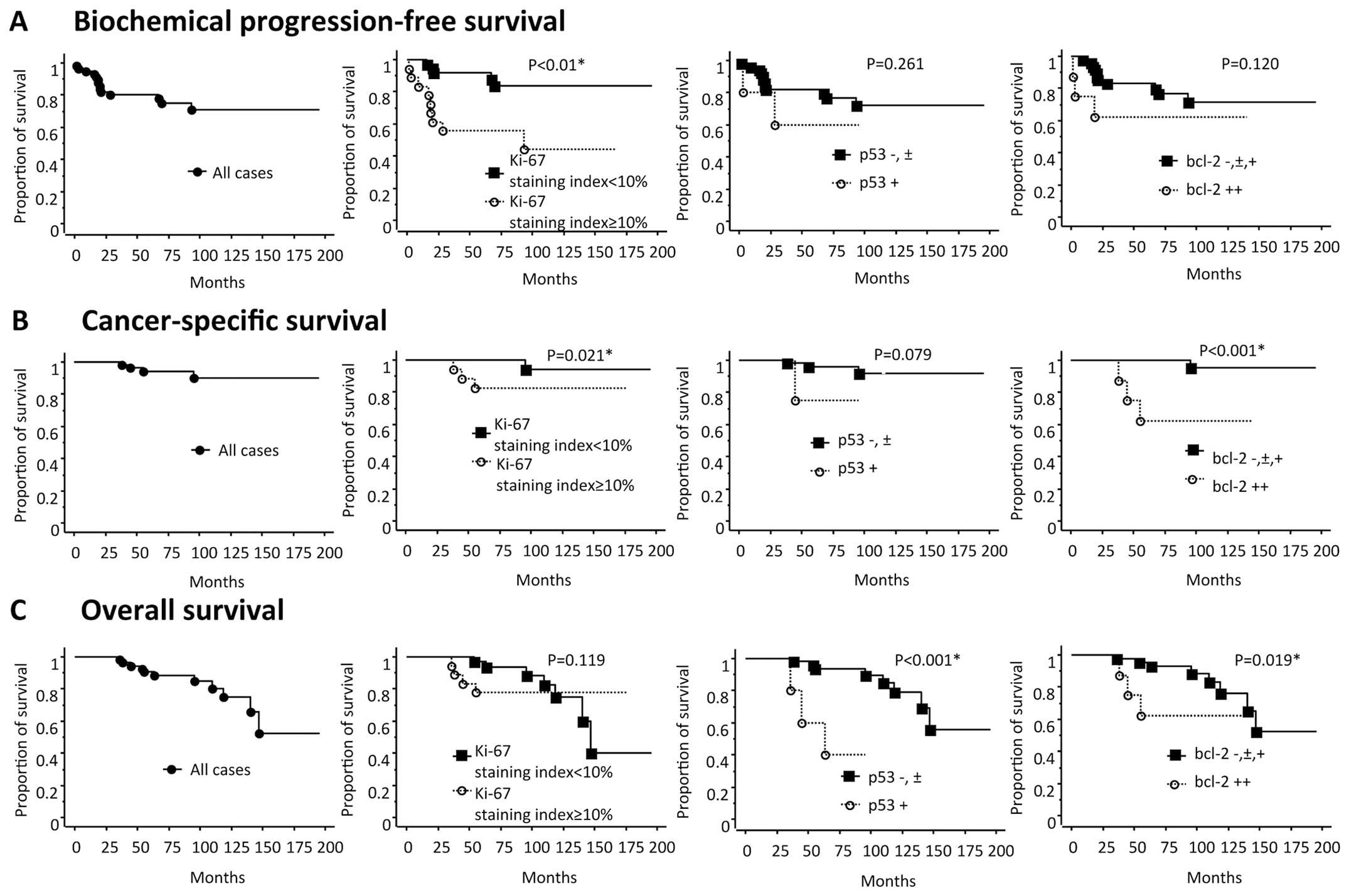|
1.
|
Kononen J, Bubendorf L, Kallioniemi A, et
al: Tissue microar-rays for high-throughput molecular profiling of
tumor specimens. Nat Med. 4:844–847. 1998. View Article : Google Scholar : PubMed/NCBI
|
|
2.
|
Kallioniemi OP, Wagner U, Kononen J and
Sauter G: Tissue microarray technology for high-throughput
molecular profiling of cancer. Hum Mol Genet. 10:657–662. 2001.
View Article : Google Scholar : PubMed/NCBI
|
|
3.
|
Braunschweig T, Chung JY and Hewitt SM:
Perspectives in tissue microarrays. Comb Chem High Throughput
Screen. 7:575–585. 2004. View Article : Google Scholar
|
|
4.
|
Tsurutani J, Fukuoka J, Tsurutani H, et
al: Evaluation of two phosphorylation sites improves the prognostic
significance of Akt activation in non-small-cell lung cancer
tumors. J Clin Oncol. 24:306–314. 2006. View Article : Google Scholar : PubMed/NCBI
|
|
5.
|
Fukuoka J, Dracheva T, Shih JH, et al:
Desmoglein 3 as a prognostic factor in lung cancer. Hum Pathol.
38:276–283. 2007. View Article : Google Scholar : PubMed/NCBI
|
|
6.
|
Fukuoka J, Fujii T, Shih JH, et al:
Chromatin remodeling factors and BRM/BRG1 expression as prognostic
indicators in non-small cell lung cancer. Clin Cancer Res.
10:4314–4324. 2004. View Article : Google Scholar : PubMed/NCBI
|
|
7.
|
Tsuna M, Kageyama S, Fukuoka J, et al:
Significance of S100A4 as a prognostic marker of lung squamous cell
carcinoma. Anticancer Res. 29:2547–2554. 2009.PubMed/NCBI
|
|
8.
|
Rubin MA: Use of laser capture
microdissection, cDNA micro-arrays, and tissue microarrays in
advancing our understanding of prostate cancer. J Pathol.
195:80–86. 2001. View
Article : Google Scholar : PubMed/NCBI
|
|
9.
|
Rubin MA, Dunn R, Strawderman M and Pienta
KJ: Tissue microarray sampling strategy for prostate cancer
biomarker analysis. Am J Surg Pathol. 26:312–319. 2002. View Article : Google Scholar : PubMed/NCBI
|
|
10.
|
Inoue T, Segawa T, Shiraishi T, et al:
Androgen receptor, Ki67, and p53 expression in radical
prostatectomy specimens predict treatment failure in Japanese
population. Urology. 66:332–337. 2005. View Article : Google Scholar : PubMed/NCBI
|
|
11.
|
Yasuda K, Komiya A, Watanabe A, et al:
Expression of hepatocyte growth factor activator inhibitor type-1
(HAI-1) in prostate cancer. Anticancer Res. 33:575–581.
2013.PubMed/NCBI
|
|
12.
|
Komiya A, Yasuda K, Nozaki T, Fujiuchi Y,
Hayashi S and Fuse H: Small cell carcinoma of the prostate after
high-dose-rate brachytherapy for low-risk prostatic adenocarcinoma.
Oncol Lett. 5:53–56. 2013.PubMed/NCBI
|
|
13.
|
Komiya A, Yasuda K, Watanabe A, Fujiuchi
Y, Tsuzuki T and Fuse H: The prognostic significance of loss of the
androgen receptor and neuroendocrine differentiation in prostate
biopsy specimens among castration-resistant prostate cancer
patients. Mol Clin Oncol. 1:257–262. 2013.
|
|
14.
|
Fukuoka J, Hofer MD, Hori T, et al: Spiral
array: a new high-throughput technology covers tissue
heterogeneity. Arch Pathol Lab Med. 136:1377–1384. 2012. View Article : Google Scholar : PubMed/NCBI
|
|
15.
|
Zellweger T, Gunther S, Zlobec I, et al:
Tumour growth fraction measured by immunohistochemical staining of
Ki67 is an independent prognostic factor in preoperative prostate
biopsies with small-volume or low-grade prostate cancer. Int J
Cancer. 124:2116–2123. 2009.
|
|
16.
|
Miyake H, Muramaki M, Kurahashi T,
Takenaka A and Fujisawa M: Expression of potential molecular
markers in prostate cancer: correlation with clinicopathological
outcomes in patients undergoing radical prostatectomy. Urol Oncol.
28:145–151. 2010. View Article : Google Scholar
|
|
17.
|
Oxley JD, Winkler MH, Parry K, Brewster S,
Abbott C and Gillatt DA: p53 and bcl-2 immunohistochemistry in
preoperative biopsies as predictors of biochemical recurrence after
radical prostatectomy. BJU Int. 89:27–32. 2002. View Article : Google Scholar : PubMed/NCBI
|
|
18.
|
Ecke TH, Schlechte HH, Schiemenz K, et al:
TP53 gene mutations in prostate cancer progression. Anticancer Res.
30:1579–1586. 2010.PubMed/NCBI
|
|
19.
|
Nariculam J, Freeman A, Bott S, et al:
Utility of tissue microarrays for profiling prognostic biomarkers
in clinically localized prostate cancer: the expression of BCL-2,
E-cadherin, Ki-67 and p53 as predictors of biochemical failure
after radical prostatectomy with nested control for clinical and
pathological risk factors. Asian J Androl. 11:109–118. 2009.
|
|
20.
|
Cho IC, Chung HS, Cho KS, et al: Bcl-2 as
a predictive factor for biochemical recurrence after radical
prostatectomy: an interim analysis. Cancer Res Treat. 42:157–162.
2010. View Article : Google Scholar : PubMed/NCBI
|
|
21.
|
Fleischmann A, Huland H, Mirlacher M, et
al: Prognostic relevance of Bcl-2 overexpression in surgically
treated prostate cancer is not caused by increased copy number or
translocation of the gene. Prostate. 72:991–997. 2012. View Article : Google Scholar : PubMed/NCBI
|
|
22.
|
Abdollah F, Suardi N, Cozzarini C, et al:
Selecting the optimal candidate for adjuvant radiotherapy after
radical prostatectomy for prostate cancer: a long-term survival
analysis. Eur Urol. 63:998–1008. 2013. View Article : Google Scholar
|
|
23.
|
Kumar S, Shelley M, Harrison C, Coles B,
Wilt TJ and Mason MD: Neo-adjuvant and adjuvant hormone therapy for
localised and locally advanced prostate cancer. Cochrane Database
Syst Rev. CD0060192006.PubMed/NCBI
|
|
24.
|
Chun FK, Steuber T, Erbersdobler A, et al:
Development and internal validation of a nomogram predicting the
probability of prostate cancer Gleason sum upgrading between biopsy
and radical prostatectomy pathology. Eur Urol. 49:820–826. 2006.
View Article : Google Scholar
|
|
25.
|
Imamoto T, Utsumi T, Takano M, et al:
Development and external validation of a nomogram predicting the
probability of significant gleason sum ppgrading among Japanese
patients with localized prostate cancer. Prostate Cancer.
2011:7543822011. View Article : Google Scholar : PubMed/NCBI
|
|
26.
|
Camp RL, Charette LA and Rimm DL:
Validation of tissue microarray technology in breast carcinoma. Lab
Invest. 80:1943–1949. 2000. View Article : Google Scholar : PubMed/NCBI
|
|
27.
|
Kyndi M, Sorensen FB, Knudsen H, et al:
Tissue microarrays compared with whole sections and biochemical
analyses. A subgroup analysis of DBCG 82 b&c. Acta Oncol.
47:591–599. 2008.PubMed/NCBI
|















